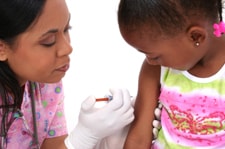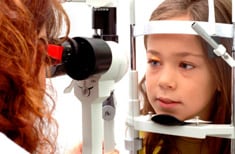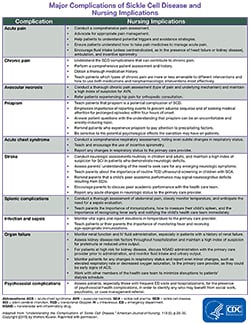Complications and Treatments of Sickle Cell Disease
People with sickle cell disease (SCD) start to have signs of the disease during the first year of life, usually around 5 months of age. Symptoms and complications of SCD are different for each person and can range from mild to severe.
The reason that infants don’t show symptoms at birth is because baby or fetal hemoglobin protects the red blood cells from sickling. When the infant is around 4 to 5 months of age, the baby or fetal hemoglobin is replaced by sickle hemoglobin and the cells begin to sickle.
SCD is a disease that worsens over time. Treatments are available that can prevent complications and lengthen the lives of those who have this condition. These treatment options can be different for each person depending on the symptoms and severity.
Hydroxyurea (pronounced hye droks ee yoor EE a) is a medicine that can decrease several complications of SCD. This treatment is very safe when given by medical specialists experienced in caring for patients with SCD. However, the side effects of taking hydroxyurea during pregnancy or for a long time are not completely known. The Food and Drug Administration has also approved a new medicine to reduce the number of sickle cell crises in adults and children older than age five; it is called Endari (L-glutamine oral powder). Another treatment, which can actually cure SCD, is a stem cell transplant (also called a bone marrow transplant); this procedure infuses healthy cells, called stem cells, into the body to replace damaged or diseased bone marrow (bone marrow is the center of the bone where blood cells are made). Although transplants of bone marrow or blood from healthy donors are increasingly being used to successfully cure SCD, they require a matched donor (a person with similar, compatible bone marrow), and transplants can sometimes cause severe side effects, including occasional life-threatening illness or death. People with SCD and their families should ask their doctors about the benefits and risks of each treatment option.
Hand-Foot Syndrome
Swelling in the hands and feet usually is the first symptom of SCD. This swelling, often along with a fever, is caused by the sickle cells getting stuck in the blood vessels and blocking the flow of blood in and out of the hands and feet.
Treatment
The most common treatments for swelling in the hands and the feet are pain medicine and an increase in fluids, such as water.
Major SCD Complications and Nursing Implications
Pain “Episode” or “Crisis”
Pain is the most common complication of SCD, and the number 1 reason that people with SCD go to the emergency room or hospital. When sickle cells travel through small blood vessels, they can get stuck and clog the blood flow. This causes pain that can start suddenly, be mild to severe, and can last for any length of time.
Prevention
There are simple steps that people with SCD can take to help prevent and reduce the number of pain crises, including the following:
- Drink plenty of water.
- Try not to get too hot or too cold.
- Try to avoid places or situations that cause exposure to high altitudes (for example, flying, mountain climbing, or cities with a high altitude).
- Try to avoid places or situations with exposure to low oxygen levels (for example, mountain climbing or exercising extremely hard, such as in military boot camp or when training for an athletic competition).
- Adults with severe SCD can take a medicine called hydroxyurea to help reduce the number of pain crises.
- People taking hydroxyurea are checked often by a doctor to prevent complications, including an increased risk of infections.
- Research shows that babies and children with SCD can also benefit from hydroxyurea therapy.
Treatment
Most pain related to SCD can be treated with over the counter pain medications such as ibuprofen and aspirin. Some people who have severe pain are given opioid (i.e. morphine) medications daily, along with additional pain medication. Some people may be admitted to the hospital for intense treatment.
Fast Fact
Taking iron supplements will not help people with sickle cell disease. This type of anemia is not caused by too little iron in the blood; it’s caused by not having enough red blood cells. In fact, taking iron supplements could harm a person with sickle cell disease because the extra iron builds up in the body and can cause damage to the organs.
Anemia
Anemia is a very common complication of SCD. With SCD, the red blood cells die early. This means there are not enough healthy red blood cells to carry oxygen throughout the body. When this happens, a person might have:
- Tiredness
- Irritability
- Dizziness and lightheadedness
- A fast heart rate
- Difficulty breathing
- Pale skin color
- Jaundice (yellow color to the skin and whites of the eyes)
- Slow growth
- Delayed puberty
Treatment
Blood transfusions are used to treat severe anemia. A sudden worsening of anemia resulting from infection or enlargement of the spleen is a common reason for a transfusion. Multiple blood transfusions, however, might cause health problems because of the iron content of blood. Iron overload, called hemosiderosis, can damage liver, heart, pancreas and other organs, leading to diseases such as diabetes mellitus. Iron chelation therapy should be started in patients with SCD receiving regular blood transfusions to reduce excess iron levels.
Infection

People with SCD, especially infants and children, are more at risk for infections, especially those due to bacteria with capsules because of damage to the spleen. Pneumonia is a leading cause of death in infants and young children with SCD.
Prevention
Vaccines can protect against harmful infections.
- Washing your hands is one of the best ways to help prevent getting an infection. People with SCD, their family, and other caretakers should wash their hands with soap and clean water many times each day.
- Because bacteria in some foods can be especially harmful to children with SCD, food should be prepared safely.
- Vaccines can protect against harmful infections. Children with SCD should get all regular childhood vaccines, plus a few extra. Adults should have the flu vaccine every year, as well as the pneumococcal vaccine and any others recommended by a doctor.
- Take penicillin (or other antibiotic prescribed by a doctor) every day until at least 5 years of age.
Treatment
Infections are treated with antibiotic medicines and sometimes blood transfusions. At the first sign of an infection, such as a fever, it is important to see a doctor right away as this may represent a medical emergency for people with SCD. Early treatment of infection can help prevent problems.
Acute Chest Syndrome

This can be life-threatening and should be treated in a hospital. Symptoms and signs are similar to pneumonia. Signs and symptoms include chest pain, coughing, difficulty breathing, and fever.
Prevention
Adults with severe SCD can take a medicine called hydroxyurea to help prevent acute chest syndrome. People taking hydroxyurea are monitored closely with regular blood testing and dose adjustments to prevent complications.
A person who is on bed rest or has recently had surgery can use an incentive spirometer, also called “blow bottle,” to help prevent acute chest syndrome.
Treatment
Depending on the cause, treatment might include oxygen, medicine to treat an infection, medicine to open up airways to improve air, and blood transfusions.
Splenic Sequestration
This can be life-threatening and should be treated in a hospital. It happens when a large number of sickle cells get trapped in the spleen and cause it to suddenly get large. Symptoms include sudden weakness, pale lips, fast breathing, extreme thirst, abdominal (belly) pain on the left side of body, and fast heartbeat.
Parents of a child with SCD should learn how to feel and measure the size of their child’s spleen and seek help if the spleen is enlarged.
Prevention
For those who have had a very severe, life-threatening episode of splenic sequestration or who have had many episodes in the past, it might be necessary to have regular blood transfusions or the spleen can be removed (called splenectomy) to stop it from happening again.
Treatment
Treatment typically is a blood transfusion. This should be done in consultation with a blood specialist as patients sometimes become overloaded with fluid when the blood is released from the spleen. Removal of blood may be necessary to prevent this from happening.
Vision Loss

Vision loss, including blindness, can occur when blood vessels in the eye become blocked with sickle cells and the retina (the thin layer of tissue inside the back of the eye) gets damaged. Some patients develop extra blood vessels in the eye from the lack of oxygen.
Prevention
People with sickle cell disease should have their eyes checked every year to look for damage to the retina. If possible, this should be done by an eye doctor who specializes in diseases of the retina.
Treatment
If the retina is damaged by excessive blood vessel growth, laser treatment often can prevent further vision loss.
Leg Ulcers
This usually occurs on the lower part of the leg. They happen more often in males than in females and usually appear from 10 through 50 years of age. A combination of factors cause ulcer formation, including trauma, infection, inflammation, and interruption of the circulation in the smallest blood vessels of the leg.
Treatment
Leg ulcers can be treated with medicated creams and ointments. Leg ulcers can be painful, and patients can be given strong pain medicine. Management of leg ulcers could also include the use of cultured skin grafts. This treatment is provided in specialized centers. Bed rest and keeping the leg (or legs) raised to reduce swelling is helpful, although not always possible.
Stroke
A stroke can happen if sickle cells get stuck in a blood vessel and clog blood flow to the brain. About 10% of children with SCD will have a symptomatic stroke. Stroke can cause learning problems and lifelong disabilities.
Prevention
Children who are at risk for stroke can be identified using a special type of exam called, transcranial Doppler ultrasound (TCD). If the child is found to have an abnormal TCD, a doctor might recommend frequent blood transfusions to help prevent a stroke. People who have frequent blood transfusions must be watched closely because there are serious side effects. For example, too much iron can build up in the body, causing life-threatening damage to the organs.
Deep Vein Thrombosis (DVT) and Pulmonary Embolism (PE)
Sickling of red cells can increase blood coagulation and induce an increased risk of blood clot in a deep vein (DVT), or in the lung (PE) if the blood clot moves from the deep veins. People with SCD have a high chance of developing DVT or PE. DVT and PE can cause serious illness, disability and, in some cases, death.
Prevention and Treatment
Medication is used to prevent and treat DVT and PE. PE requires immediate medical attention. For more information on DVT and PE visit https://www.cdc.gov/ncbddd/dvt/index.html.
Other Possible Complications
- Damage to body organs (like the liver, heart, or kidneys), tissues, or bones because not enough blood is flowing to the affected area(s).
- Malnutrition and growth retardation among adolescents can cause a delayed onset of puberty and, in males, infertility.
- Gallstones.
- Painful erection of the penis, called priapism, can last less than 2 hours or more than 4 hours. If it lasts more than 4 hours, the person should get urgent medical help. It can lead to impotence.
- A very rare form of kidney cancer (renal medullary carcinoma) has been associated with sickle cell trait.






















.jpg)










No hay comentarios:
Publicar un comentario